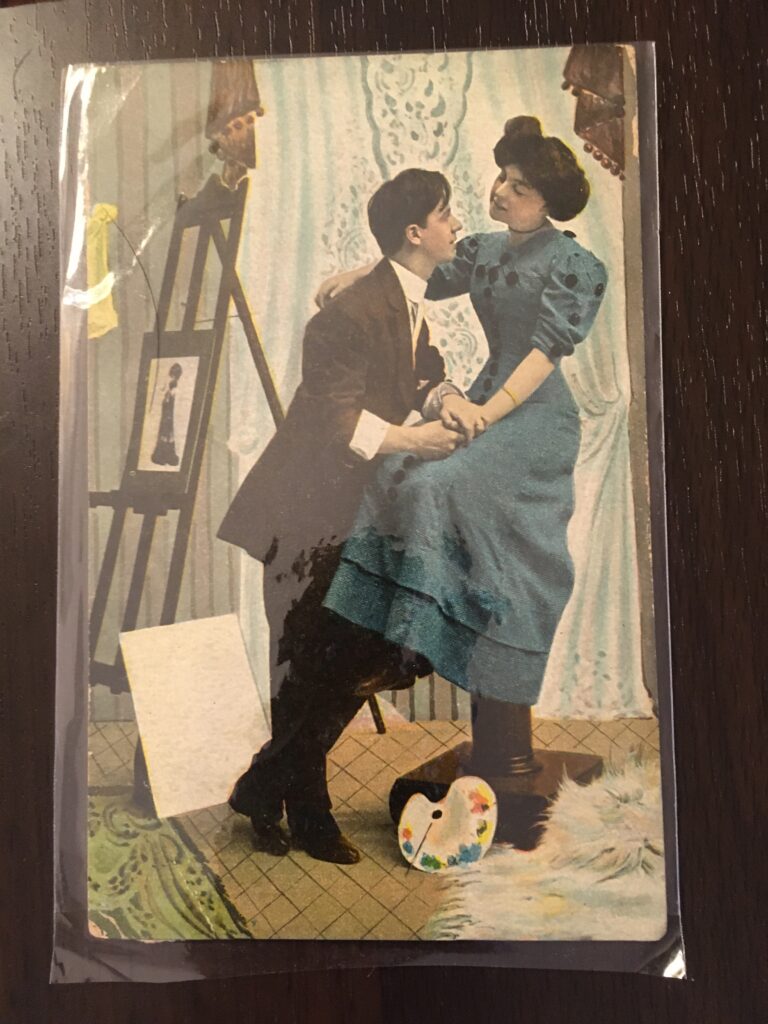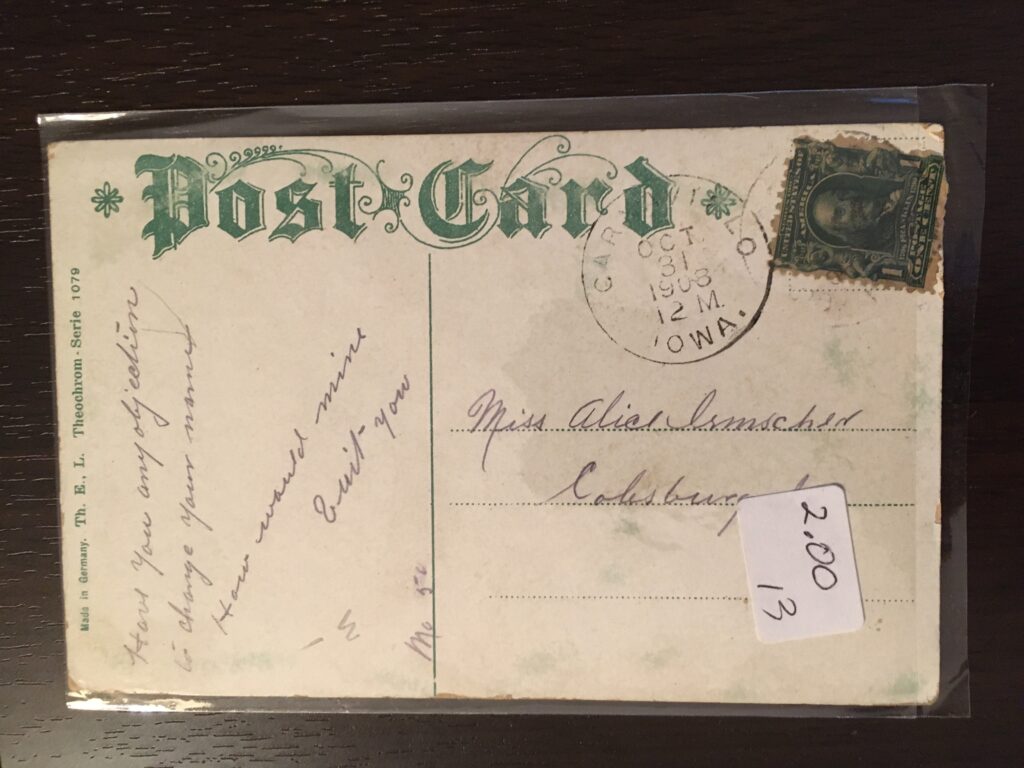“How would mine suit you?”: Proposing Marriage by Postcard
Since the first post centered around a birth announcement, today we’re moving on to another key life event for many (not all) people: marriage. As with the birth announcement, this is a semi-random card. I admit that I picked it up largely for the text–but I have no other cards sent to or from the recipient and sender. It’s a lonely-only.

By lonely-only, however, I mean strictly in terms of sender/recipient/inscription. The card itself was mass-produced, after all. I have at least one other instance of this same card sent by someone else to someone else. I might even have two. I remember many of my cards, but not all–I’ve got a lot and I haven’t finished processing them.
The image itself is rather pretty, to my mind. The expressions on their faces are reasonable and potentially romantic–this is a point worth considering. There are a lot of old postcards out there that are supposed to be romantic but are actually rather skeevy, or feature behaviors that fall into categories of harrassment. This doesn’t seem to be one of them, a point in its favor since the inscription on the reverse is implicitly romantic.
Let’s take a step back and talk about processing. I’ve started researching postcard collections at libraries and historical societies, in particular collections that institutions have or are in the process of digitizing. As I mentioned yesterday, a lot of postcard collecting focuses on the images. Therefore it will likely come as no surprise that the designers of digitized collections tended/tend to focus on images and information about production. Thus visitors may search or browse by maker, designer, and visual elements. The full record of any given card will include available information including sender, recipient, inscription, stamp(s), and/or postmark(s). These fields or may not be browsable and/or indexed. (I’ll talk more about why these matter in later posts.)
At this time, I’m using spreadsheets to gather information about my collection. Down the road, some or all of the information I bring together will be put in a database. I’m not designing one because I anticipate someday donating the collection as a whole to an institution (special collections library) with a partially-digitized collection and database–and a condition of the donation will be expansion of the database to incorporate the most important elements of my spreadsheets to allow researchers to readily sort and group these postcards, at least, by additional criteria.
Since I anticipate eventual conversion of my spreadsheets into fields in a database, I’ve invested a fair amount of time in figuring out what information matters and key relationships between pieces of data. For example, I want to be able to analyze my collection–particularly the large batches of cards sent to one or more person–by the type of relationship between sender and recipient. Therefore, I had to decide how granular/and or details to make this element. I went for general categories such as relative, friend, or business connection–or unknown, if I couldn’t guess based on the card. For senders who directed a large number of cards to the same person or family, I will eventually conduct external research to pinpoint more precisely the relationship (if it’s referenced in the card, such as addressed to aunt or uncle, I am noting this in the sender name fields). The idea however is to someday be able to say that of the various groupings that form my collection which do I have cards primarily between friends or relatives.
For those who’ve born with me this far, now on to the reverse of the card:

This particular postcard has a stamp and postmark. Stamp collectors might be able to tell a lot based on the stamps and their conditions. In processing cards, I note whether or not they have stamps and if they’re foreign (or more than a 1c Benjamin Franklin) but otherwise don’t pay them much attention. Postmarks, on the other hand, they’re quite useful–at least when they’re legible. They give me a hard-and-fast date and/or place. My spreadsheets contain separate columns recording whether there’s a postmark or not, the state (or country), city, and date broken into year, month, and day. I do admit to not recording the time. If there’s more than one postmark–which is the case in many instances–I record the second (and third, as available) although only the oldest date. That means that I can sort to see what cards were sent around the same time (historians like chronologies, after all!) and do some geographic network analysis someday.
Since it went through the post, there’s also an address. Only a city, but that’s still something. Larger cities have specific addresses. Small towns sometimes include specifications, either by sender or postal staff, as to which rural route the recipient lives on. This is all wonderful information to have. Many wonderful cards and groups of cards were hand-delivered, and may lack any indication of when or where they were used.
Then there’s the message. The proposal. A bit roundabout, but definitely suggestive that the sender would like the recipient (a single woman given the “Miss”) to change their last name to match his. One would hope this did not come as any kind of surprise to Miss Alice Imscher, but we’ll never know. Since the sender didn’t provide a legible signature of any kind, and the card has been separated from any others she might have kept, there are few options to figure out what happened.
By the way, if you see any prices on the cards ignore them. I buy cards in batches–or in albums–and either negotiate the price down or bid and hope that other bidders don’t drive it up. In those cases where you see a price listed, it represents what some seller hoped to receive. Postcard prices vary widely based on condition, rarity of image, how collectible they are, and much more. That’s one more reason I switched to buying albums (though I’ve mostly stopped because I’ve got enough on hand for ample analysis).
And that’s all for today. Since the first post was on birth, and this marriage, you may be able to guess what the third will be about . . .
“”How would mine suit you?”: Proposing Marriage by Postcard,” copyright 2021, A.R. Henle.
